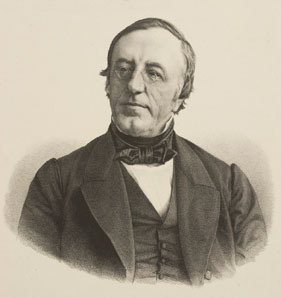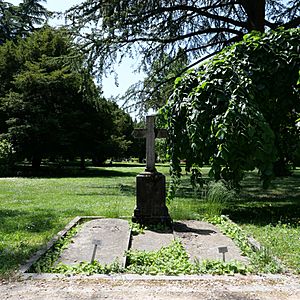Auguste Arthur de la Rive facts for kids
Quick facts for kids
Auguste Arthur de la Rive
|
|
|---|---|
 |
|
| Born | 9 October 1801 Geneva, Switzerland
|
| Died | 27 November 1873 (aged 72) Marseilles, France
|
| Nationality | Swiss |
Auguste Arthur de la Rive (born October 9, 1801 – died November 27, 1873) was a famous Swiss scientist. He was a physicist, which means he studied how the world works through things like energy and forces. In 1845, he was the President of the Helvetic Society of Natural Science. This was a big group for scientists in Switzerland.
De la Rive's first science paper was published in 1822. It was about how the Earth's magnetism affects electric currents. For fifty years, he wrote many important science papers. These were published in well-known science journals in Geneva.
Contents
A Young Scientist's Life
Auguste de la Rive was born in Geneva, Switzerland. His father, Charles-Gaspard de la Rive, was also a scientist. He studied medicine and became a professor in Geneva.
When Auguste was just 22 years old, he became a professor himself. He taught natural philosophy at the same university his father taught at. This subject was like what we call physics today.
Early Research and Discoveries
For some years, Auguste worked with another scientist, François Marcet. They studied how much heat gases could hold. They also looked into the temperature deep inside the Earth.
But Auguste was most interested in electricity. He especially studied how voltaic cells (early batteries) work. He also researched how electricity moves through gases that have very little air in them.
Inspired by Electric Discoveries
Auguste started his science work when electricity and magnetism were new and exciting fields. His father was involved in these discoveries. Many famous scientists visited their home. This likely made Auguste love studying electricity. He continued to research it throughout his life. Most of his many published papers were about electricity.
Amazing Electrical Inventions
His studies on electricity in thin gases led him to a new idea. He developed a theory about what causes the aurora borealis. This is the beautiful natural light display in the sky, also known as the Northern Lights.
In 1840, he invented a way to electro-gild silver and brass. This means he found a way to put a thin layer of gold onto these metals using electricity. The next year, he won a big prize for this invention from the French Academy of Sciences.
His Big Book on Electricity
De la Rive's most important work was a huge book. It was called Treatise on Electricity in Theory and Practice. It had three volumes and came out between 1854 and 1858. This book was published in both French and English at the same time.
In this book, he explained his theory about the Aurora Borealis. He showed an experiment where an electric arc (a bright spark) could spin around a magnet. This was like how he thought the aurora worked. His book was seen as very accurate and helpful for anyone studying electricity.
A Voice for His Country
Auguste de la Rive was from a well-known family. This gave him a lot of influence in society and politics. He was known for welcoming many writers and scientists to his home. He also cared deeply about his home country, Switzerland.
In 1860, there was a worry that France might try to take over Geneva. De la Rive was sent to England by his fellow citizens. He successfully got the English government to say that attacking Geneva would be seen as an act of war. Because of this important visit, the university of Oxford gave him an honorary degree.
Later Years and Legacy
In the spring of 1873, Auguste de la Rive's health began to get worse. He showed signs of paralysis. Even so, he gave his yearly report to the science society he used to lead.
In November, he started a trip to Cannes, France, for the winter. But on the second day of his journey, he had another stroke. He passed away in Marseilles, France, on November 27, 1873. He was 72 years old. Scientists around the world were very sad to hear of his passing.
His Published Works

Besides his big Treatise on Electricity, he also worked on many science journals.
- From 1836 to 1845, he edited parts of the Bibliothèque universelle de Genève.
- He also put together five volumes of "Archives de l'Electricité" by himself.
- Later, with other scientists, he helped create and edit the "Archives des Sciences Physiques et Naturelles."
His Family
Auguste de la Rive married Jeanne-Mathilde Duppa in 1826. She was a writer. Their son, Lucien de la Rive, also became a scientist. He wrote papers on math and physics. He also studied how electric waves travel. In 1855, Auguste married Louise Maurice.
See also
 In Spanish: Auguste Arthur de la Rive para niños
In Spanish: Auguste Arthur de la Rive para niños


